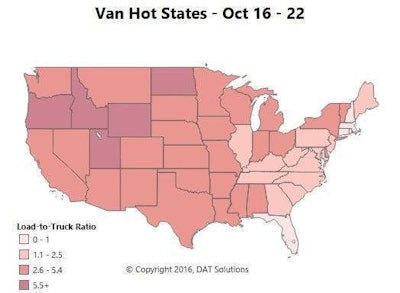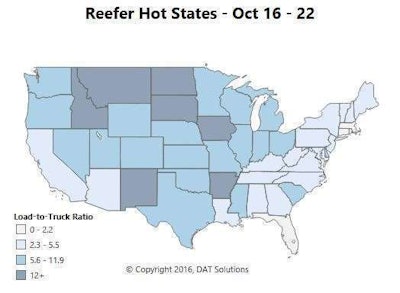It looks like Hurricane Matthew had a fourfold impact on van freight in the Southeast. There was a surge before the storm, and a slump during the hurricane itself. Then there was another surge in freight to bring in relief supplies. The roads are mostly open again, but it’s likely that normal business was still disrupted last week, because rates and volumes were down.
Flatbed freight was up in the region, though, which means rebuilding efforts are underway. Nationally, flatbed load posts increased 6.6 percent last week, as truck posts held steady. That caused the load-to-truck ratio to rise for the second consecutive week, up 6.3 percent to 15.6 loads per truck.
 Three areas traditionally considered as “backhaul markets” saw big increases in volumes and rates on DAT Load Boards: Denver, Seattle and Buffalo. There are still a lot of loads in L.A. and Stockton, Calif., as well. Rates in the Southeast fell back to earth after a one-week surge following the storm. Highway closures also made moving freight more expensive. The roads are open now, and the average outbound rate from Charlotte dropped 22 cents.
Three areas traditionally considered as “backhaul markets” saw big increases in volumes and rates on DAT Load Boards: Denver, Seattle and Buffalo. There are still a lot of loads in L.A. and Stockton, Calif., as well. Rates in the Southeast fell back to earth after a one-week surge following the storm. Highway closures also made moving freight more expensive. The roads are open now, and the average outbound rate from Charlotte dropped 22 cents. Reefer volumes crested a couple of weeks ago. Volumes held mostly steady last week, but rates slipped slightly. The focus is shifting to Mexican produce, as harvests are mostly completed for the season in the Upper Midwest. That’s led to higher rates and volumes out of the border markets of Nogales, Ariz., and McAllen, Texas. Volumes were also up in Dallas and Ontario, Calif., but not enough to put pressure on reefer rates yet.
Reefer volumes crested a couple of weeks ago. Volumes held mostly steady last week, but rates slipped slightly. The focus is shifting to Mexican produce, as harvests are mostly completed for the season in the Upper Midwest. That’s led to higher rates and volumes out of the border markets of Nogales, Ariz., and McAllen, Texas. Volumes were also up in Dallas and Ontario, Calif., but not enough to put pressure on reefer rates yet.








